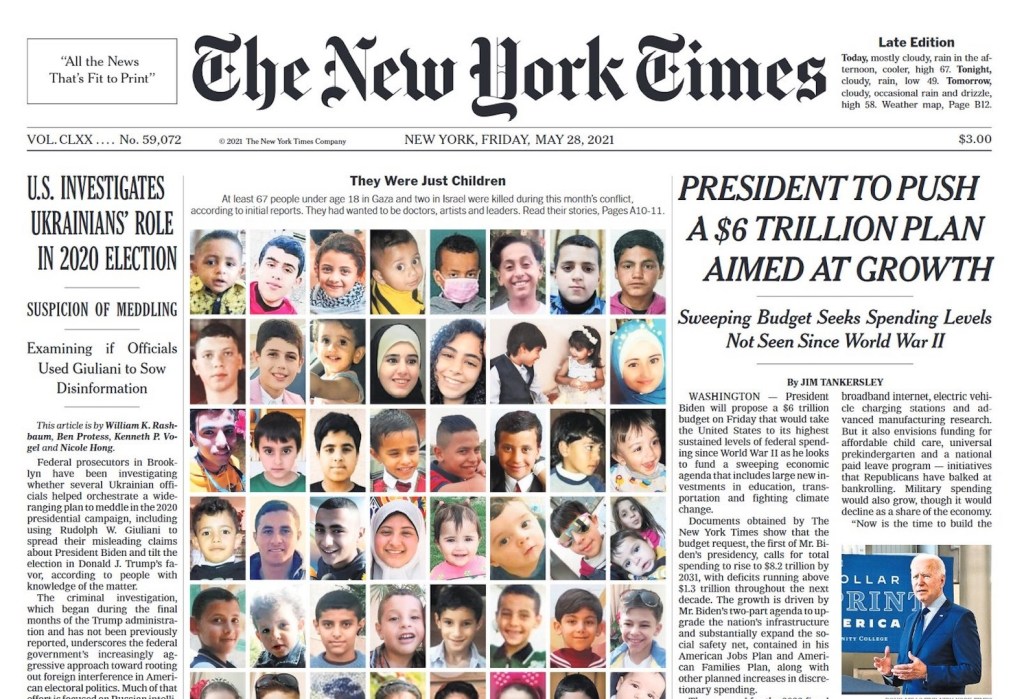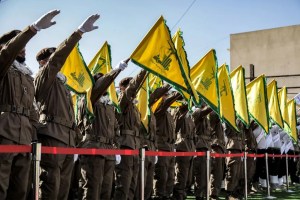While war raged between Israel and Gaza, the New York Times published a powerful montage of 64 minors said to have been killed in the conflict so far.
Under its famous motto ‘All the news that’s fit to print’, and with the headline ‘They Were Only Children’, America’s paper of record informed us that ‘they had wanted to be doctors, artists and leaders’ and invited us to read their stories.
It was impossible to look at those innocent faces without feeling deeply distressed. This was the human cost of the Israeli war machine, brought directly to your breakfast table, in a way that the vicious Turkish assault on the Kurds in April — or, for that matter, the Royal Air Force’s recent ‘major air offensive’ in Iraq — was not. The unspoken conclusion was clear: the Jewish state was uniquely wicked.
But in the days that followed, things began to fray at the edges. The digital investigations agency DigFind did the job that the Times journalists had neglected, confirming the identities of those pictured. That put rather a different complexion on things.
The first disclosure was that a charming photograph of a girl wrapped in a keffiyeh and smiling confidently in the first row of the collage was not, as the paper had claimed, 10-year-old Rahaf al-Masri. It was an unidentified picture from 2015.
How had the error occurred? Well, the fake image had simply been circulating on Twitter. This had apparently been enough for the New York Times to run with it — though it was not, of course, enough for the sleuths who followed their tracks, nor, one would have thought, for the public.
The unraveling gathered pace. It soon emerged that 17-year-old Khaled al-Qanoi, pictured in the fourth row of the Times’s heartrending montage, was in fact a fighter in the al-Mujahedeen Brigades, a terror group in Gaza.
A straightforward Facebook search brought up multiple images of al-Qanoi aiming rocket-propelled grenades, and posing in front of the militant group’s flag wearing a headband and brandishing an automatic weapon.
Had the Times journalists thought of checking Facebook, they may have found al-Qanoi’s eulogistic ‘martyr video’, put together by his terrorist comrades. Some social media posts carry more weight than others, it seems, where a certain 130 Pulitzer Prize-winning title is concerned.
Things were not looking good for the ill-fated front page. And they were only getting worse. It emerged that 15-year-old Mohammed Suleiman, on the second row of the montage, was the son of Saber Suleiman, a prominent Hamas commander.
Once again, it was unclear why the Times journalists had neglected to look at Facebook. If they had, they would have unearthed a video of Suleiman père et fils in matching combat fatigues, firing a heavy weapon together.
They would also have found photographs of young Mohammed brandishing an assault rifle at home, in the woods and while astride a horse, clad in a military uniform.
Initial reports claimed that father and son had been killed by an Israeli drone strike while ‘on their agricultural land outside the city of Jabalia’. Tending their crops, no doubt.
As the days ticked past, more holes began to appear in the already threadbare New York Times splash. There were suggestions that at least ten of the children pictured may have been killed by some of the 600-odd Hamas rockets that mistakenly landed in Gaza.
None of this makes any of it OK. It just makes it more complicated. Fifteen-year-old Mohammed Suleiman and 17-year-old Khaled al-Qanoi would fit the definition of child soldiers, an outrage found all over the world and one of the greatest social evils of our times. And it should be unnecessary to state that the death of any child, indeed any civilian, in combat is an unspeakable tragedy.
Though perhaps not so unspeakable for fanatical terror groups like Hamas, which intentionally use ordinary people, including children, as human shields.
Whenever Israel goes head-to-head with Hamas, there are two wars being fought. The first is the real-world conflict, in which Israel takes action to degrade the enemy and protect its citizens and Hamas tries to kill them. The second is a propaganda war, in which Hamas seeks to paint the Jewish state as the bogeyman, undermining its international legitimacy in the long term.
Using ordinary Gazans as human shields is a powerful way of achieving this (when you value victory above innocent life). Exaggerating the numbers of civilian dead and downplaying the numbers of combatants is another. Shepherding journalists selectively around Gaza is also effective. And putting misinformation into the public domain is another key tactic, which has a huge impact on regional geopolitics.
Every Israel-Gaza conflict sees fake images, often from atrocities in Syria, repackaged as Israeli aggression and circulated online. On one memorable occasion during the 2014 war, an image of a decapitated child from the Hollywood horror film Final Destination 4 was presented by pro-Hamas propagandists as a Palestinian victim. It was eventually exposed; but not before it was viewed hundreds of thousands of times.
This ‘fauxtography’ has been a key part of the Hamas propaganda campaign for years. And it works. The exaggerations, half-truths and untruths snowball online, sparking passionate rallies all over the world and placing immense pressure on international policymakers.
This was evident in the recent conflict. Even 1,000 rockets fired at Israel in a single day was not enough to galvanize meaningful international support for the Jewish state, or indeed any serious condemnation of Hamas. This has a knock-on effect in the real world. Next time Hamas decides to unleash a rocket barrage, Israel will have more limited ability to retaliate, as the international community will already be against it.
That’s where the New York Times comes in. It goes without saying that it’s impossible to report objectively on any story when your editorial line has been decided in advance. The latest Israeli campaign was more accurate than any recent war, with combatants accounting for the vast majority of the dead. All of this is lost when you sacrifice the facts for emotive photographs of children.
Don’t get me wrong. Emotive photographs have their place, and we must never lose touch with the tragic cost of war. But from the point of view of the victims, there is a certain indignity in the fact that they have been used to further a political agenda. And from the point of view of the Times, it is troubling that its journalists have participated in doing so.
When the front page was published, Brad Parker, a representative of the NGO, Defense for Children International Palestine (DCIP), tweeted his thanks to the Times for ‘reaching out to us at @DCIPalestine to help make this front page’.
This was revealing. As was evident from his Twitter name, to which he had appended the hashtag #SaveSheikhJarrah, Mr Parker was not an entirely dispassionate observer of the conflict. And a quick look at the DCIP website shows that it is hardly objective, either. What exactly did the New York Times expect when it asked them for ‘help’?
It has long been an aphorism of journalism that if one man says it’s raining and another says it’s dry, it’s not your job to quote them both, but to look out of the window and see for yourself.
If the Times journalists had followed the basic tenets of their profession, America’s paper of record would not have become a pawn in the chess game of Hamas. To have the Gray Lady contribute towards Hamas’ war aims was a major boon for the terror group — and another dark day for journalism.
This article was originally published on The Spectator’s UK website.


















